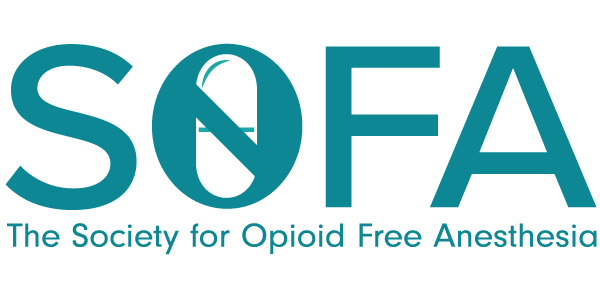SOFA Sit-Down featuring Tom Baribeault
Welcome to the first installment of the “SOFA Sit-Down!” The Series that allows you to be the interviewer. We will have medical professionals, patients, and passionate people ready to answer all your questions. From the serious to the quirky, they’ll do their best to give the answers you need! This edition, we have Tom Baribeault, CRNA, joining us! Enjoy!
What first sparked your interest in OFA?
Strangely enough, Opioid-Free Anesthesia (OFA) wasn’t my goal when I started giving anesthesia, but rather something that developed out of everything I learned along the way. During my anesthesia training, one of the groups I was training with utilized a lot of esmolol infusions to reduce intra-operative opioid consumption and post-operative pain. I was fascinated with the seemingly counter-intuitive concept that decreasing “pain” medicine during a surgery would decrease pain after surgery.
This led me to do a research project and presentation on the pathophysiology of surgical pain, opioid-induced hyperalgesia/tolerance, and other pharmacologic methods of reducing intra-operative opioid use. Word of mouth about this presentation spread, and I received many invitations to present this information.
After school, I took my first job in an anesthesia group with an active acute pain management practice. Soon after I joined them, they began getting involved in the Enhanced Recovery After Surgery (ERAS) movement and implementing ERAS protocols for various types of surgery. Through this process, I learned even more about how opioids delay healin g, prolong hospital stays, and how to manage post-operative pain without them.
How did you first go about putting OFA into your practice?
Throughout this time period, the opioid, obesity, and chronic pain epidemics were all rapidly growing, while the general population was getting older and sicker. Opioids were quickly becoming less effective and less well-tolerated by patients. I began combining techniques for reducing intra-op opioids with ERAS protocols for reducing post-op pain, and the amount of opioids that patients required during surgery dropped dramatically.
It wasn’t long before the doses of opioids I was giving during surgery was so absurdly small I had to ask myself why I was even giving them. At this point, I still had never heard of OFA, and I wasn’t trying to systematically eliminate all opioids from my anesthesia. I was simply giving the best anesthesia I knew how and finding that most of the time I needed very little to none. However, what immediately became very clear to me was how much better patients did when they did not receive any opioids during the surgery.
These patients breathed much better, had less pain, rarely had any PONV, and if they did require an opioid for pain afterwards, they required far less than the patients who did receive opioids intra-op.
Why did you change your practice?
Personal experience and the literature published on this subject showed me that the traditional opioid-based anesthetic has a difficult time adequately managing a patient’s pain and other side effects. All the changes to our patient population that were already discussed, make opioids even less effective and desirable. I wanted to do a better job for my patients and that is why I have spent all the time and energy learning how to give OFA and teaching others to do the same.
What obstacles did you encounter transitioning to practicing OFA?
Patients
One of the great things about OFA is that it puts control into the hands of the patient at a time when they are scared. Many patients are afraid of post-operative pain, nausea, don’t like how opioids make them feel, or are afraid of addiction or relapse. With OFA, you can tell your patient that you will give them a variety of non-opioid pain medications during surgery which will reduce their post-op pain and nausea. If they need an opioid medication for pain in the recovery room after they’re awake, it’ll be available for them, but the important thing is that they don’t have to have any and it’s their decision.
Anesthesia Colleagues
The anesthesia world still has a long way to go before there is widespread acceptance of strategies like OFA and ERAS. It often takes several generations of providers before the research and knowledge that we have today is taught, understood, and accepted by the majority. Fentanyl was created in 1960 and has been one of the cornerstones of anesthesia since then. That means for over 50 years (almost 3 generations of providers) we have been giving opioids as one of fundamental parts of our anesthetic. Many providers are unaware or don’t believe the research showing the harmful effects of opioids and many don’t believe that anesthesia can be given without them. Similarly, we have a long way to go educating providers on the pathophysiology of surgical pain and how to treat that process most effectively.
On a more basic level, it can create tension and issues when someone in a group practices in a way that others in that group are not familiar with. For example, it’s the end of the day and a provider who is unfamiliar with OFA goes to take over a case from one who is providing OFA. The provider who is taking over might refuse to take the case, might merely feel uncomfortable while finishing the case not knowing what to expect, the patient may have a delayed wake up because the provider doesn’t know how to time emergence from this type of anesthetic leading to that provider feeling resentful for looking bad in front of the surgeon, or blame the original provider for the delayed wake up. The ability to discuss these issues and create a plan before they cause problems is a necessary skill to have when practicing OFA.
Surgeons
Surgeons can be the biggest advocate for or biggest obstacle to providing OFA. Many surgeons want the best for their patients and request OFA and work hard to set up ERAS protocols. Other surgeons never venture from the way they were trained and refuse to allow their patients to have the benefit of these techniques. I have found if you can find at least one surgeon who is willing to work with you and set up a comprehensive plan for their patients, and you do a good job caring for those patients, eventually the other surgeons will see how much better that surgeon’s patients are doing and ask you for the same.
What was the hardest lesson you learned while transitioning to OFA?
The biggest challenges in developing and implementing OFA actually come from being forced to face my own shortcomings as a person. I tend to be stubborn, determined to do things my way, and willing to completely ignore anyone who tries to prevent me from doing what I want. But in trying to bring OFA to a wider audience and gain acceptance and implementation from others, I have been forced to learn how to get past my own shortcomings.
What are some of your favorite cocktails for MACs and TIVAs?
The first thing I’ll say is that regional anesthesia makes everything better. If there is a block to do, do it before surgery and that makes your job that much easier. With the advent of fascial plane blocks, there is almost nothing that is not blockable. ENT/Facial cases may be the exception to that rule (and there are even blocks for that) but just not nearly as popular or as well known.
As far as intra-op management goes, ketamine, alpha-2 agonists, lidocaine, and beta blockers are the go to drugs. The biggest learning curve with OFA is that all the drugs we use are long-acting so for shorter cases you have to give small doses so you don’t delay wake-up. I’ll give an example of what I might typically give for a short 20-30 minute MAC case as well as for a >4 hour long TIVA case. In both instances, I would be titrating a propofol infusion for sedation.
MAC
ketamine 10-20 mg based on age and number of pain meds currently taking
lidocaine 1.5mg/kg (yes, I actually figure this out and give that dose and not just 100 mg)
For MAC cases, I don’t always add an alpha-2 agonist. Both dexmedetomidine and clonidine are very long-acting drugs, and I don’t find the alpha-2 activity to be as effective at blocking movement as ketamine. If it’s a very painful procedure, or the patient has history suggesting that they might need the added analgesia, I will give a small dose, 100 mcg clonidine or 25-50 mcg dexmedetomidine.
TIVA
ketamine 0.5 mg/kg bolus followed by 0.5 mcg/kg/min
lidocaine 1.5 mg/kg followed by 2 mg/kg/hr
clonidine 0.2 mcg/kg followed by 0.2 mcg/kg/hr or dexmedetomidine 0.5 mg/kg followed by 0.5 mcg/kg/hr
Of course these are averages to give you an example. It’s important to evaluate every patient and determine if this is an appropriate technique for that patient and procedure.
Given the up front cost of the medication regimen. How do you approach the argument from admins, pharmacy etc… against opioid free anesthesia due to the cost of some of the medications and agents?
There are numerous angles you can take on this subject. With very few exceptions, the drugs we use in OFA are generic and inexpensive. While very little beats the cost of opioids, which are obscenely cheap, the cost difference isn’t substantial. Other discussions you can have is that there is a cost savings in reduced hospital stays and PACU discharge times. Collect data for a period of time tracking hospital stays for inpatients and/ or discharge home times for outpatients. If you can (and you will be able to) show a reduced hospital time for your patients, that is a huge cost savings for the hospital. Other things to talk about is the safety factor. With OFA, the risk of respiratory events is significantly reduced, and just one respiratory arrest is very costly for the hospital.
“I’d love to hear advice for those of us that are working at trauma centers. Frequently have ex-laps, open fractures that end up coming back repeatedly. Can’t always give PO meds, and sometimes surgeons are afraid of blocking.” – Sam Marusich
Those are very challenging cases both from a co-morbidity and from a pain perspective. There are several classes of medications that can help you.
NMDA blockers can be your best friend in cases where the patient has to have several surgeries in a short period of time and is on high-dose opioid therapy in between. Ketamine, magnesium, and nitrous oxide all, to some degree, prevent and reverse the central sensitization that is causing the pain pathways to be upregulated and the opioid-induced hyperalgesia/tolerance that they ndoubtedly have developed.
Lidocaine infusions are a great choice for abdominal surgery patients when you can’t do a block. Studies show it is not as effective in the orthopedic and “bone pain” cases but it’s perfect for an ex-lap.
These are difficult cases and these patients are often very sick. You have to know the absolute and relative contraindications for each of them and weigh the risk of giving a medication that can worsen their condition with the benefit of reducing the pain they are having. Sometimes the best anesthetic is the safest, but then you will find times that you are able to greatly reduce someone’s pain and suffering, and that is a noble accomplishment.
“I’m an SRNA in metro Detroit. I’m curious how you manage opioid tolerant individuals. Perfect example is patients who are going for repeat back surgeries who take high dose oral opioids around the clock. Hospital is not on board with pre-op oral meds like pregabalin. I’m able to greatly reduce my opioid usage to minimal or non-existent, except for intubation, for the average patient. But for the opioid tolerant patient; I’m having trouble. I’ll administer magnesium (usually 1-2 grams), ketamine (usually .3-.5 mg/kg TBW), lidocaine, IV Tylenol. I’ll use nitrous as part of my anesthetic. (I know opinions are divided, but i’m a fan of it.) We don’t have IV clonidine/precedex. I’ll still end up administering a large amount of opioids. It is definitely less than the average provider, but I’d like to reduce it even further. Any advice?
-Also I’ve read that opioid free anesthesia is bigger in Europe. Any advice on seminal articles on the topic? I understand Jan Mulier is a trailblazer. Anyone else to read up on?”
-Michael Tonelli SRNA
This is a great question, and one that doesn’t have a simple answer. One of the primary reasons for giving OFA is to protect the bodies nervous system from the hyperalgesic changes that opioids cause. The patient on chronic opioids has already had those changes occur, and so there is much less reason to avoid opioids in this patient population. Also, while they may no longer have an adequate analgesic response to opioids, they will have a hyperalgesic response if they start to withdraw.
For this reason, in this patient population, I think it is very important to make sure that as a bare minimum they take their normal daily opioid medication, and typically I am not afraid to give them more on top of that. However, if you are having trouble with the stimulation of intubation, I would consider adding 0.5-1 mg/kg esmolol to get you through your induction. Plenty of research articles out there on this technique you can look up. Esmolol lasts about 5-10 minutes, will block the stimulation of intubation, and get you through the induction process.
I’ve recently discovered that there ARE some interesting discussions happening on Twitter under the hashtag #opioidfreeanesthesia.
If you have someone you’d like to see featured on the “SOFA Sit-Down,” send an email to info@goopioidfree.com!





